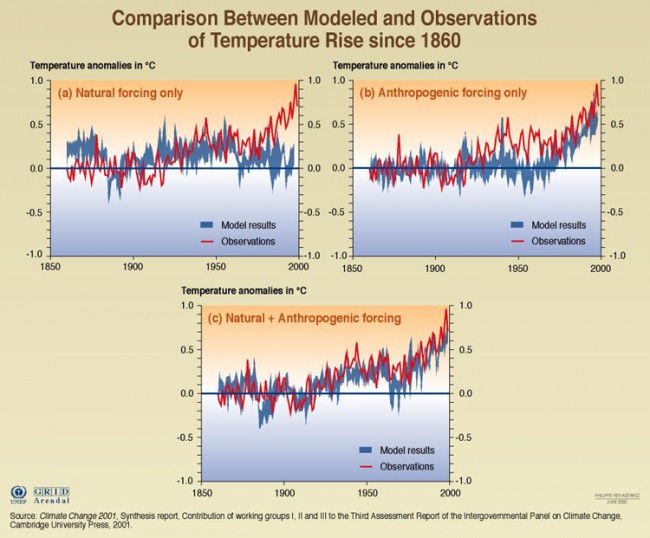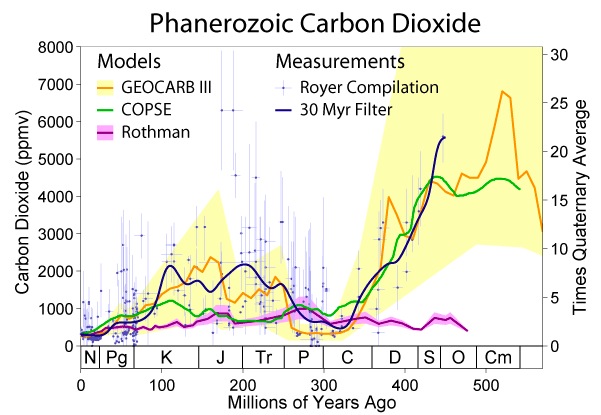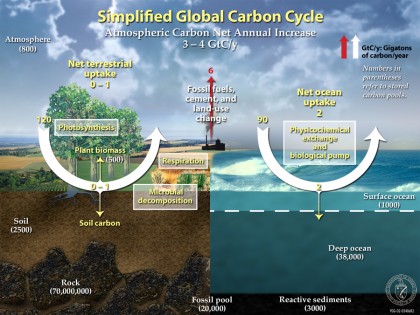7 July 2009
New Clue to Past CO2 Levels??
Posted by Dan Satterfield
A fascinating article has been published in Nature this week. It concerns the levels of atmospheric CO2 in the past, and it is sure to elicit plenty of comment in the scientific community. Understand that when a paper like this is published, it is not accepted as an answer, but as only a beginning of a discussion.
First some background- trust me this is interesting- even if your not a weather weenie like me.
You might be surprised to know that 33 million years ago, the CO2 levels in Earths atmosphere were very high. Nearly 1400 parts per million. Compared with about 390 ppm today. The Earth was VERY warm because of this too. Then levels began dropping.
We know this from proxy measurements of CO2, in the deep past. Primarily from measurements made in ocean bottom cores. (super geeks go here) You can measure certain isotopes and come up with the level of CO2 at the time. You can then check your measurements with ice cores from Antarctica and the current instrument measurements to see if you are getting an accurate measurement. This is SOP in the science world.
So what caused the drop. Weathering of rocks is one way. Decreasing output from volcanoes likely played a role as well. The primary way was probably increased weathering as mountains rose. CO2 today is taken from the atmosphere by chemical reactions and eventually gets buried as silt in the oceans. This process is part of the carbon cycle. It’s understood quite well.
Something seems to stop the drop when the CO2 levels reach 200 ppm. If it had dropped below 200 ppm, the Earth possibly would have remained in a permanent ice age. At the least it would have gotten much colder. The question is why did it never go below 200 ppm even when the earth was in an ice age. Why has it stayed much lower over the last 5 million years?
This mystery just MIGHT have an answer.
PLANTS
Mark Pagani of Yale and others have proposed that when the levels of CO2 dropped below about 300 ppm the forests disappeared and were replaced by grasslands. Grasslands, unlike trees, do not have big roots that break up rocks as they grow. Breaking up rocks speeds up weathering and the CO2 cycle. It’s long been thought that CO2 levels started dropping at the end of the Eocene, (about 30 million years ago) because of the uplift of mountains. As the mountains rise up the weather rates increase, and more CO2 is sequestered under the oceans.
Pagini et.al have proposed this negative feedback kicks in and that keeps the levels from going too low.
Are they right? Time may tell. It is very dangerous to jump onto any just published paper to support a cause. Gavin Schmidt explains why, much better than I can in a post today on Real Climate.
As the editor of Nature wrote. It’s bold and provocative!
If you are wondering how this relates to Climate change today, then the answer is that anytime we better understand the past, we can better predict the future. CO2 levels by the end of this century could be approaching 1000 ppm. Still well below that of the Eocene.

From IPCC 2001 We can only replicate the real world warming by including all the factors. If you leave out the CO2 increase, the planet would have cooled.
The difference is that this time it’s not natural. It’s us. The results will likely be the same though. The physics of CO2 has been well understood for 100 years. (Despite some of the silly junk science put out online by those who find science does not work well with their politics)
We do know that CO2 levels dropped and by the time of the Holocene the Earth underwent multiple ice ages, interrupted by brief warming periods. We came out of the last one completely around 10,000 years ago and have had rather stable temps. since. (Until the late 20th century). The climate system is complicated. Solar output, changes in Earths orbit and internal feed-backs all play a role.
The public tends to try and focus on only one cause and effect. They all play a role though and most are understood quite well.
The Sun for instance would have caused us to cool slightly or hold steady over the last 50 years. (So much for “It’s the sun stupid” Solar Expert Judith Lean in video) Earth’s orbital changes would have also left us pretty much stable, and perhaps a bit cooler.
Guess what? Cosmic Rays have almost no effect despite that book on the shelves of many bookstores. Real science shows that any “cosmic” effect would have actually cooled us, not warmed us.
The Nature article is interesting for what is tells about the past, more than what it might say about the future. If they are right, we have discovered another of mother natures climate mechanisms. That would be good in itself. How it will play out in future predictions is a long way off. At this stage, it seems like it will not be a major factor either way.
We are heading in the direction of too much CO2- not too little! Is there a feedback that will kick in and save us if we get the CO2 too high? Maybe. You wanna find out? I don’t.




 Dan Satterfield has worked as an on air meteorologist for 32 years in Oklahoma, Florida and Alabama. Forecasting weather is Dan's job, but all of Earth Science is his passion. This journal is where Dan writes about things he has too little time for on air. Dan blogs about peer-reviewed Earth science for Junior High level audiences and up.
Dan Satterfield has worked as an on air meteorologist for 32 years in Oklahoma, Florida and Alabama. Forecasting weather is Dan's job, but all of Earth Science is his passion. This journal is where Dan writes about things he has too little time for on air. Dan blogs about peer-reviewed Earth science for Junior High level audiences and up.
There were many deep glacial periods in Precambrian time that exercise the minds of many of our best geoscientists, with no definitive answer as to their cause and termination. Likewise there have been very warm periods. But surely the argument now is how best to stop the anthropogenic component of climate change, for the sake of the many vulnerable communities suffering disasters like floods, avalanches, fires and sea-level rising. The geological past is a distraction in this sense!